This article needs additional citations for verification .(July 2024) |
Leo of Inis Airc was an early medieval Irish Christian saint.
This article needs additional citations for verification .(July 2024) |
Leo of Inis Airc was an early medieval Irish Christian saint.
Inishark lies south-west of Inishbofin, Galway and was inhabited up to 1960. Leo is the patron saint of the island, and responsible for perhaps the first Christian settlement on the island. He lived in the 7th century. [1]
A church which is reputed to have been founded by Leo, now in ruins, is called Teampaill Leo. It features a stone cross, known as Leac Leo. On the nearby south shore is Uaimh Leo, a cave where he is said to have prayed and meditated. Clochán Leo is a large Beehive hut in a stone enclosure.[ citation needed ]
A 19th-century church was erected on the site of his monastery.
His feast day was originally 11 April but later celebrated on 10 November.

Lindisfarne, also called Holy Island, is a tidal island off the northeast coast of England, which constitutes the civil parish of Holy Island in Northumberland. Holy Island has a recorded history from the 6th century AD; it was an important centre of Celtic Christianity under Saints Aidan, Cuthbert, Eadfrith, and Eadberht of Lindisfarne. The island was originally home to a monastery, which was destroyed during the Viking invasions but re-established as a priory following the Norman Conquest of England. Other notable sites built on the island are St Mary the Virgin parish church, Lindisfarne Castle, several lighthouses and other navigational markers, and a complex network of lime kilns. In the present day, the island is an Area of Outstanding Natural Beauty and a hotspot for historical tourism and bird watching. As of February 2020, the island had three pubs, a hotel and a post office.
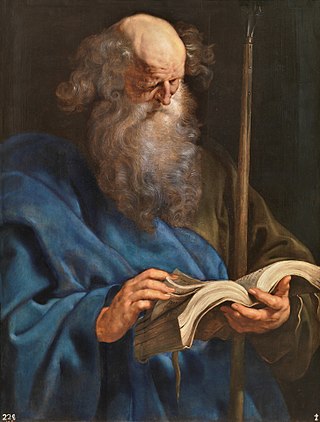
Thomas the Apostle, also known as Didymus, was one of the Twelve Apostles of Jesus according to the New Testament. Thomas is commonly known as "Doubting Thomas" because he initially doubted the resurrection of Jesus Christ when he was told of it ; he later confessed his faith on seeing the places where the wounds had healed on the holy body of Jesus after the Crucifixion of Jesus. While it is often assumed he touched the wounds in art and poetry, the scriptures do not say that he touched the wounds, merely that Jesus invited him to do so, with it being unclear if he actually felt them.
The Culdees were members of ascetic Christian monastic and eremitical communities of Ireland, Scotland, Wales and England in the Middle Ages. Appearing first in Ireland and then in Scotland, subsequently attached to cathedral or collegiate churches; they lived in monastic fashion though not taking monastic vows.
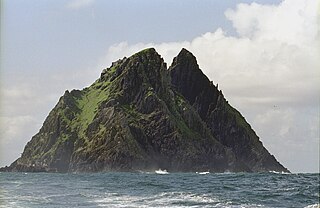
Skellig Michael, also called Great Skellig, is a twin-pinnacled crag 11.6 kilometres (7.2 mi) west of the Iveragh Peninsula in County Kerry, Ireland. The island is named after the archangel Michael, with "Skellig" derived from the Irish language word sceilig, meaning a splinter of stone. Its twin island, Little Skellig, is smaller and inaccessible. The two islands rose c. 374–360 million years ago during a period of mountain formation, along with the MacGillycuddy's Reeks mountain range. Later, they were separated from the mainland by rising water levels.

Saint Christopher is venerated by several Christian denominations as a martyr killed in the reign of the 3rd-century Roman emperor Decius, or alternatively under the emperor Maximinus Daia. There appears to be confusion due to the similarity in names "Decius" and "Daia". Churches and monasteries were named after him by the 7th century.
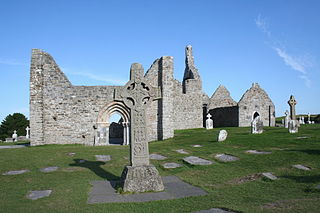
Clonmacnoise is a ruined monastery situated in County Offaly in Ireland on the River Shannon south of Athlone, founded in 544 by Saint Ciarán, a young man from Rathcroghan, County Roscommon. Until the 9th century it had close associations with the kings of Connacht.
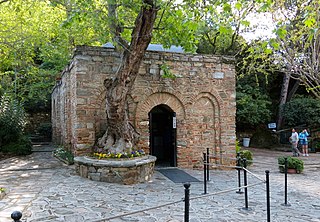
The House of the Virgin Mary is a Catholic shrine located on Mt. Koressos in the vicinity of Ephesus, 7 kilometres (4.3 mi) from Selçuk in Turkey.
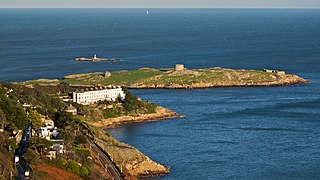
Dalkey Island is an island for which the nearby village of Dalkey is named. It is an uninhabited island located in the county of Dún Laoghaire-Rathdown, about 16 km (9.9 mi) south of Dublin and 3 km (1.9 mi) south of Dún Laoghaire harbour. An important site of pilgrimage for centuries, it has been known as "St Begnet's Isle" since records began. The earliest reference to 'Dalkey Island' is from c. 1782. The island had a population of 8 in 1841.
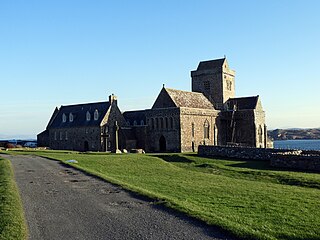
Iona Abbey is an abbey located on the island of Iona, just off the Isle of Mull on the West Coast of Scotland.
Máel Ruba is an Irish saint of the Christian Church who was active in Scotland. Originally from Bangor, County Down, Ireland, he was a monk and founded the monastic community of Applecross in Ross, one of the best attested early Christian monasteries in what is now Scotland. Forms of his name include Máelrubai, Maol Rubha (MoRubha/MaRuibhe), or Malruibhe, and it is sometimes latinised as Rufus,
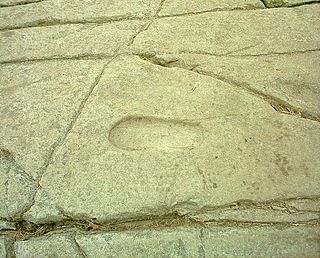
A petrosomatoglyph is a supposed image of parts of a human or animal body in rock. They occur all over the world, often functioning as an important form of symbolism, used in religious and secular ceremonies, such as the crowning of kings. Some are regarded as artefacts linked to saints or culture heroes.
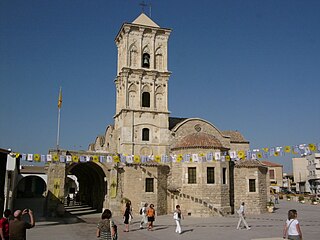
The Church of Saint Lazarus is a late-9th century church in Larnaca, Cyprus. It belongs to the Church of Cyprus, an autocephalous Greek Orthodox Church.

Saint Michael the Archangel is referenced in the Old Testament and has been part of Christian teachings since the earliest times. In Catholic writings and traditions he acts as the defender of the Church and acted as the opponent of Satan, He also assists people at the hour of death.
Gregory Ceannanach, early Irish missionary, fl. c. 490-500?
Ríoch, early Irish Christian missionary and Saint, fl. 490.
Scaithin was an early Medieval Irish saint.
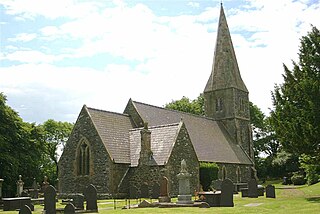
St Caffo's Church, Llangaffo is a 19th-century church, in the south of Anglesey, north Wales, about 5 miles (8.0 km) from the county town, Llangefni. It was constructed in 1846 to replace the previous medieval church in the village of Llangaffo. The new building includes a number of monuments from the old church, and has a spire which is a prominent local landmark. The churchyard has part of a stone cross dating from the 9th or 10th century, and some gravestones from the 9th to 11th centuries. It is dedicated to St Caffo, a 6th-century martyr who was killed in the vicinity.

St Caian's Church, Tregaian, also known as St Caean's Church, Tregaean, is a small medieval church dating from the 14th century in Anglesey, north Wales. It is dedicated to St Caian, a Christian from the 5th or 6th century about whom little is known. The building contains a late 14th-century east window and a late 15th-century doorway. The churchyard contains the grave of William ap Howel, who died in 1581 at the age of 105, leaving over forty children between the ages of 8 and 89 and over three hundred living descendants.

The Old Church of St Nidan, Llanidan is a medieval church in the community of Llanidan, in Anglesey, North Wales, close to the Menai Strait. The first church on the site was established in the 7th century by St Nidan, the confessor of the monastery at Penmon, Anglesey, but the oldest parts of the present structure, now closed and partly ruined, date from the 14th century. In about 1500 the church was enlarged by the addition of a second nave on the north side, separated from the earlier nave by an arcade of six arches. During 1839 till 1843 a new church was built nearby to serve the local community, partly due to the cost of repairing the old church. Much of the building was subsequently demolished, leaving only part of the western end and the central arcade. The decision was condemned at the time by Harry Longueville Jones, a clergyman and antiquarian, who lamented the "melancholy fate" of what he called "one of the largest and most important [churches] in the island of Anglesey". Other appreciative comments have been made about the church both before and after its partial demolition.

Stephen is traditionally venerated as the protomartyr or first martyr of Christianity. According to the Acts of the Apostles, he was a deacon in the early church at Jerusalem who angered members of various synagogues by his teachings. Accused of blasphemy at his trial, he made a speech denouncing the Jewish authorities who were sitting in judgment on him and was then stoned to death. Saul of Tarsus, later known as Paul the Apostle, a Pharisee and Roman citizen who would later become an apostle, participated in Stephen's martyrdom.